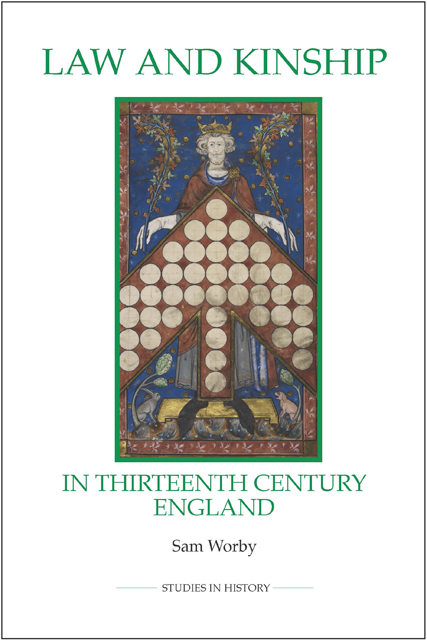Book contents
- Frontmatter
- Contents
- List of illustrations
- List of tables
- Acknowledgements
- Abbreviations
- Introduction
- 1 Canon law kinship structures
- 2 Common law kinship structures
- 3 The dominance of canon law kinship ideas
- 4 Kinship laws in practice
- 5 Trends underlying legal kinship structures
- Conclusion
- Appendices
- Bibliography
- Index
1 - Raymón of Penyafort’s Quia tractare intendimus
Published online by Cambridge University Press: 01 March 2023
- Frontmatter
- Contents
- List of illustrations
- List of tables
- Acknowledgements
- Abbreviations
- Introduction
- 1 Canon law kinship structures
- 2 Common law kinship structures
- 3 The dominance of canon law kinship ideas
- 4 Kinship laws in practice
- 5 Trends underlying legal kinship structures
- Conclusion
- Appendices
- Bibliography
- Index
Summary
This is the most popular of the thirteenth-century short canon law kinship treatises. It was written by Raymón de Penyafort, probably about 1235. The base manuscript used here is a typical set of fourteenth-century decretals, BL, MS Royal 10 D VII, fos 257v–258v (RB) . For the section of the treatise dealing with consanguinity this is compared against BL, MS Royal 6 E VI, fos 382v–384r (RA) , an extract from a mid fourteenth-century Omne Bonumcollection. For the section dealing with affinity it is compared to Winchester Cathedral Library, MS 18, fos 193v–194v (W1) , a fourteenthcentury common law statute book. This last has not been used throughout because it has several omissions, although it is reasonably consistent with the base.
It should be acknowledged that the combination of these manuscripts do not necessarily offer an edition of the original; however, they do provide an adequate view of the treatise as it circulated in the fourteenth century.
There is reportedly an edition of Quia tractare intendimus.However, it was not possible to access it, and it has been heavily criticised.
1 Quia tractare intendimus de consanguinitate et eius gradibus et de arboris consanguinitatis expositione, ad eius evidentiam pleniorem videndum est primo et prenotandum quid sit consanguinitas, unde dicatur, quid sit linea consanguinitatis et quot sunt linee, quid sit gradus et qualiter computetur usque ad quem gradum prohibeatur matrimonium.
2 Consanguinitas vero est vinculum personarum ab eodem stipite descendentium carnali propagatione contractura. Stipitem autem dico illam personam a qua aliqui duxerunt originem sicut Adam fuit stipes Caym et Abel et filiorum qui ab eis processerunt. Dicitur autem consanguinitas a communi sanguine quasi communem sanguinem habentes vel de uno sanguine procedentes.
3 Linea est ordinata collectio personarum consanguinitate coniunctarum ab eodem stipite descendentium, diversos gradus continens et eos ab unitate stipitis secundum numeros distinguens. Linearum tres sunt species: ascendentes, descendentes, transversales, sicut triplex est diversitas consanguineorum vel propinquiorum. Linea ascendentium est que continet illos a quibus originem traximus, sicut pater mater, avus avia et deinceps. Descendentium est illa que continet illos qui duxerunt originem a nobis sicut filius filia, nepos neptis et deinceps.
- Type
- Chapter
- Information
- Law and Kinship in Thirteenth-Century England , pp. 148 - 162Publisher: Boydell & BrewerPrint publication year: 2010

